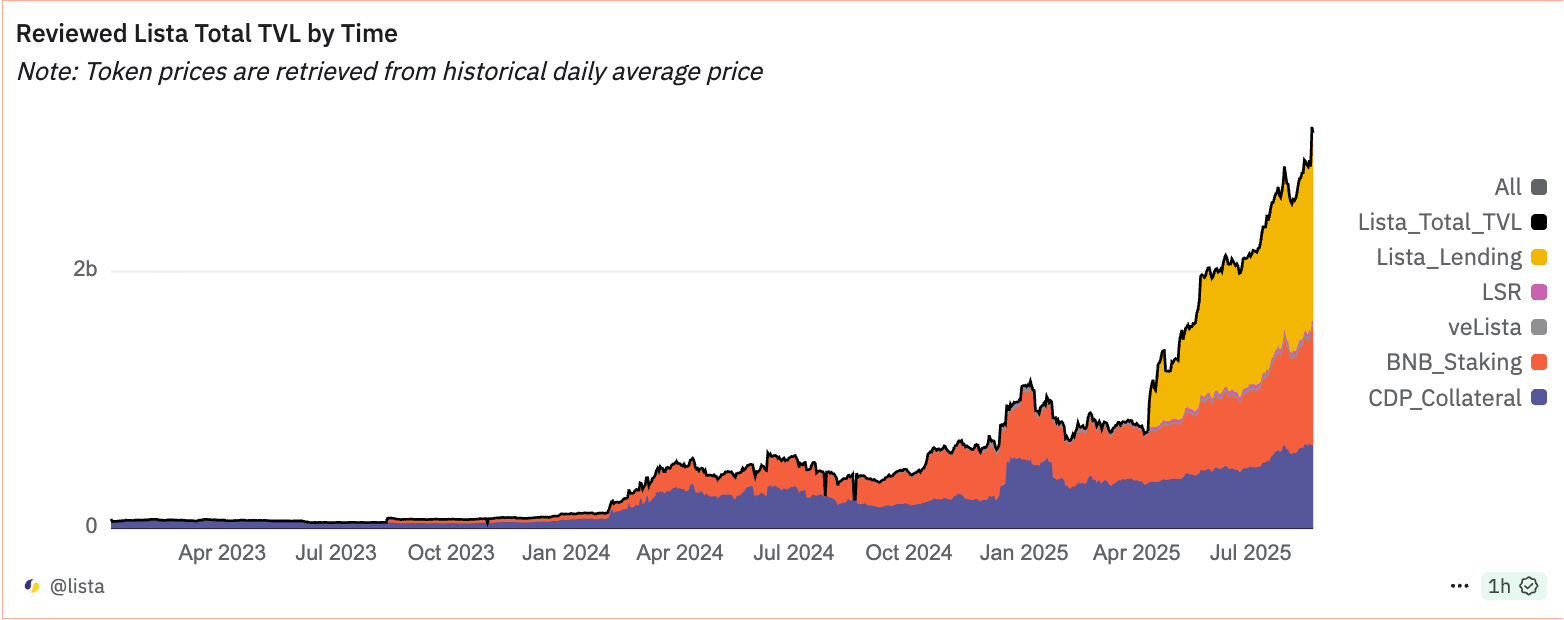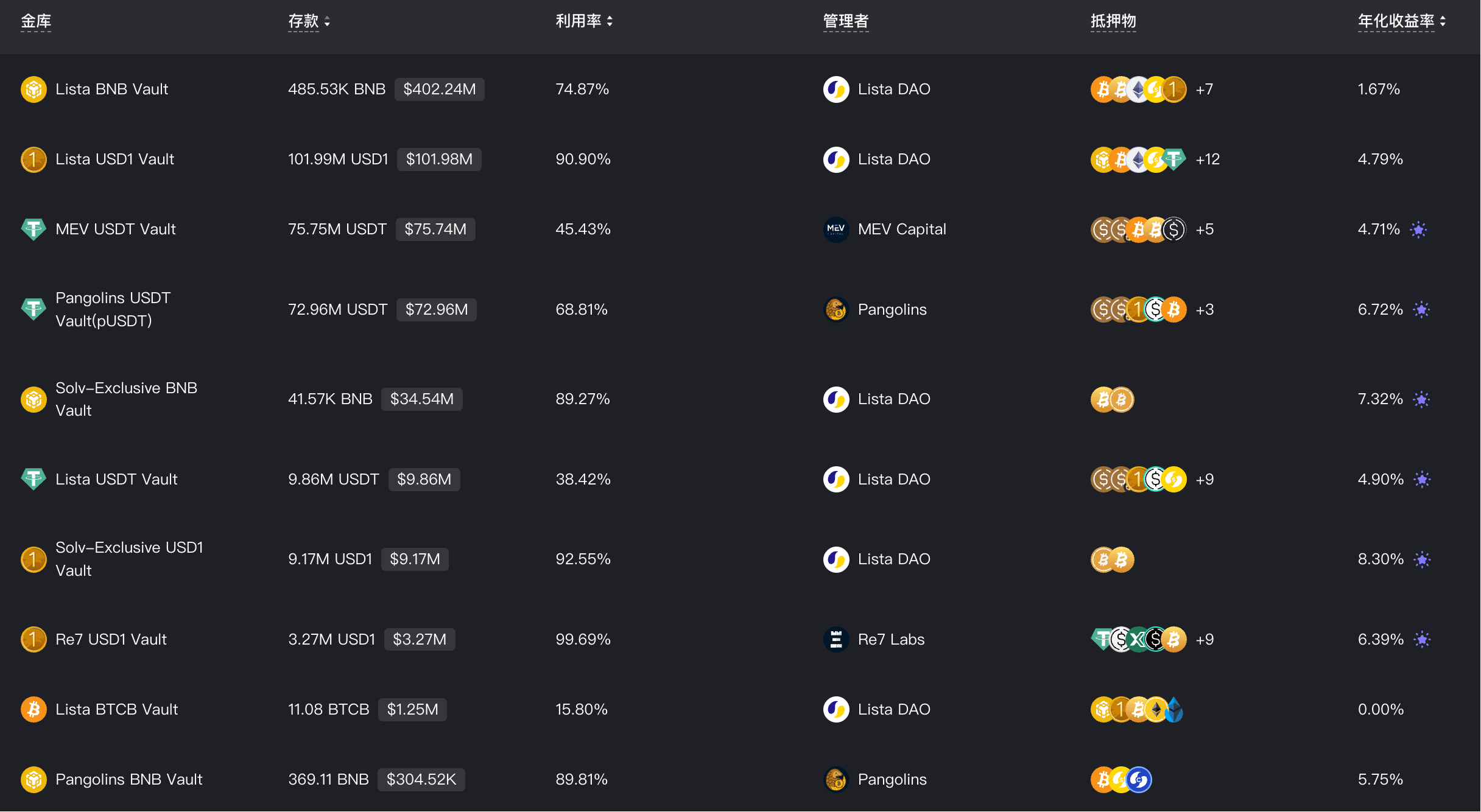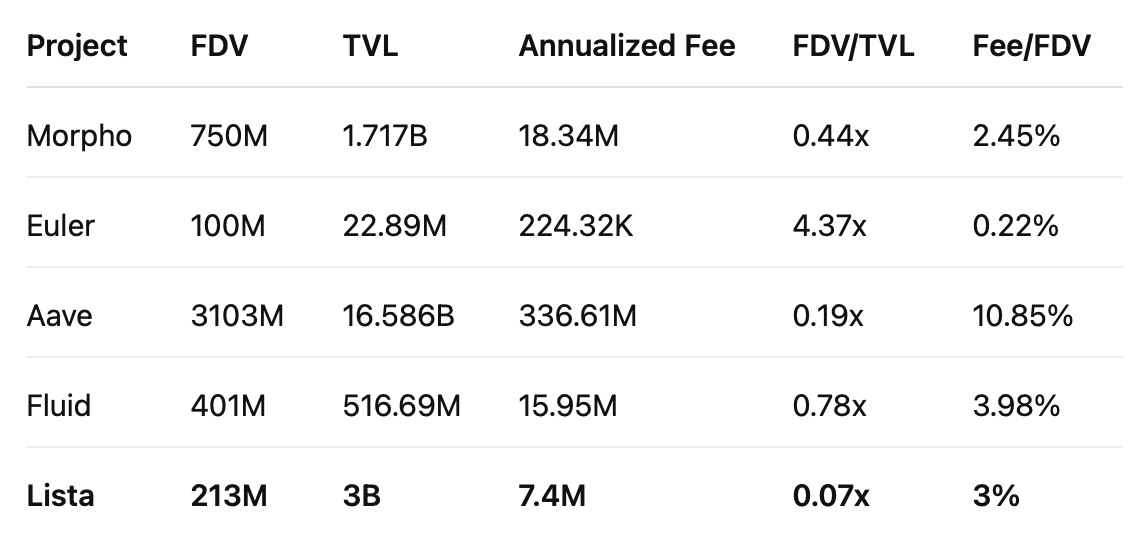Yesterday, BNB broke through $880, setting a new historical high. In this upward cycle driven by treasury strategies and structured finance, BNB Chain is no longer just a high-frequency trading network but has become the main battleground for the on-chain transformation of native assets.
And on this front, Lista DAO has quietly taken center stage, becoming the project with the highest TVL on BNB Chain. It has not only supported the largest liquid staking market in the BNB ecosystem but has also dominated multiple core asset pathways, such as stablecoins, lending, restaking, and strategy aggregation, with its TVL breaking through $3 billion.
Since Trump returned to the White House, the U.S. has rapidly pushed a series of cryptocurrency-related policies and legislation, with the most representative being the (GENIUS Act). This legislation clarifies the compliance framework for stablecoins and on-chain finance, and also provides institutional support for the cryptocurrency project WLFI led by the Trump family and its USD1 stablecoin pegged to the dollar.
In this context, USD1 is gradually becoming the core settlement asset of the BNB ecosystem, while Lista DAO has grown to be the largest on-chain liquidity hub for USD1 within just a few months, with the scale in the treasury already exceeding $100 million.
Why does the strategic gap of BNBFi need a Lista DAO?
The biggest contradiction of BNB Chain lies in its asset density and abundant liquidity but lack of a combinable on-chain revenue structure. Ethereum has Lido, Maker, Pendle, and other synergistic ecosystems that build a complete 'staking-stablecoin-leverage-strategy-structured asset' system, while the BNB ecosystem remains at the stage of 'asset launch being integration'.
For a long time, BNB assets have mainly been trapped in Binance CEX, with no standardized liquid staking protocols on-chain and lacking the lending and stablecoin infrastructure that supports leverage and revenue nesting. The lending proportion in the on-chain TVL is less than 35%, far below Ethereum's over 50%.
In this context, the systematic concept of 'BNBFi' begins to take shape; it is not a single project but the overall financial strategy of the Binance ecosystem for the on-chain transformation of native assets. Lista DAO is entering with a 'trinity' product structure, becoming the first puzzle piece in the transition of BNBFi from concept to reality. The emergence of USD1 has provided the BNB chain with a prototype of a 'structural stablecoin' for the first time, not merely a pegged asset that circulates on-chain, but an engine that can deeply participate in strategy deployment, compound returns, and liquidity aggregation.
How to construct the lifecycle of on-chain assets in BNB?
With the goal of 'all in BNBFi', Lista DAO has built a complete asset lifecycle framework for BNBFi through the combination of three types of assets: lisUSD, slisBNB, and slisBNBx, starting from BNB itself, moving into collateral or staking pathways, minting the stablecoin lisUSD, participating in various strategy deployments, leveraging or compounding returns through Lending, and facilitating new token access through slisBNBx, ultimately achieving return reinvestment and liquidity circulation.
In the future, as more assets are introduced and the market expands, Lista Lending and its derivative products will become the key support layer for the structured financial ecosystem of the BNB chain—connecting the entire closed loop system from asset generation, liquidity deployment, to strategy aggregation and revenue extraction.
Lista Lending: Reconstructing the efficiency of DeFi capital.
Lista Lending was launched in April this year, adopting a peer-to-peer architecture similar to Morpho, featuring modularity, risk isolation, and market freedom creation. Each market can independently set parameters to achieve permissionless strategy deployment and fund distribution.
This mechanism enhances the capital utilization rate on the BNB chain while completing the closed loop of Lista products: funds can enter the collateral system through slisBNB, borrow lisUSD to participate in strategy deployment, and assets can circulate and appreciate among various modules. Currently, the TVL of Lista Lending has exceeded $1.5 billion, and it can be seen from the graph that since the launch of Lending, it has become a key driving force for the growth of Lista DAO's TVL.

slisBNB and slisBNBx: Bridging staking and new token returns.
slisBNB is Lista's native liquid staking token, as a core product, it brings multiple benefits, including validator node rewards and restaking returns. slisBNBx serves as a collateral certificate token used for participating in Launchpool and other on-chain new tokens. Users can pledge BNB/slisBNB to obtain lisUSD while also minting slisBNBx to participate in new token offerings, opening up various revenue pathways.
USD1: The starting point for stablecoin strategies and the revenue hub.
In May 2025, Lista DAO completed a deep integration of the USD1 stablecoin launched by the Trump family project World Liberty Finance, incorporating it into treasury collateral assets, CDP minting logic, liquidity deployment pathways, and even the Launchpool new token mechanism, achieving almost 'full-path coverage' from user entry to strategy output. Currently, USD1 has become the starting point for strategies and the core liquidity asset within Lista, and with the integration of this political and financial trend, Lista DAO has become the circulation hub for USD1 across the network, demonstrating its ability for deep integration of external assets.
Unlike the traditional stablecoin anchoring that comes to an end, USD1 in the Lista DAO system becomes an embedded, combinable, and compound interest strategy component—this is fundamentally what distinguishes it from purely settlement stablecoins like USDT and FDUSD. As of August, the circulation of USD1 on the Lista DAO platform has exceeded $200 million, reflecting its high acceptance in the stablecoin market and validating Lista DAO's capacity as a 'liquidity backbone'.
Specifically, USD1 has two strategic roles within the Lista system:
1. As a highly adaptable entry asset, users can deposit USD1 into the Vault to unlock BNB to participate in Launchpool, or they can mortgage it in the CDP module to mint lisUSD and participate in stablecoin mining on PancakeSwap;
2. As a cross-module revenue medium, USD1 is minted by users pledging slisBNB, slisBNBx, or LP Tokens, which can then be used to access Lending and strategy Vaults, thereby achieving compound returns and completing the full-chain closed loop from asset mortgage—stablecoin generation—strategy deployment—revenue extraction. Currently, the platform has launched more than a dozen vaults, including BNB, USD1, and USDT, among which the vaults related to USD1 rank at the top in terms of deposit volume, utilization rate, and yield.

While other protocols are still at the stage of 'asset access being integration', Lista DAO has internalized USD1 as part of the platform's revenue structure, not only enhancing the DeFi usability of USD1 but also making it the most penetrating intermediary asset within the BNBFi structure. In other words, USD1 is not merely an 'asset that accesses Lista', but is transformed by Lista DAO into a 'liquidity backbone' and 'structured revenue engine'. This deep binding has also become one of Lista's largest moats relative to other BNB chain protocols.
From lisUSD to USD1, Lista DAO is gradually building a stablecoin layer oriented towards strategy adaptability and guided by revenue liquidity. This means it is no longer just a collection of DeFi protocols, but more like a 'BNBFi central bank' with open financial hub capabilities.
Strategic structural role of Lista DAO: the total entry point for BNBFi funds.
The rise of Lista DAO is not due to breakthroughs in isolated functions but is built through the simultaneous efforts of institutional, structural, and strategic mechanisms, gradually establishing an on-chain infrastructure role that is hard to bypass. Especially as BNBFi gradually evolves into the core of Binance's on-chain asset strategy, Lista DAO is no longer just a lending protocol but has become a standard layer in the release of liquidity, circulation of pledged assets, and pathways for revenue conversion.
Currently, within the BNBFi ecosystem, whether it is Pendle's PT, YT-slisBNBx, Aster's asBNB, Solv's solvBTC.BNB, or Kernel's structured assets, their contract paths almost all rely on Lista DAO's slisBNB or slisBNBx.
This means that Lista DAO is not just an application protocol, but the structural master switch for assets within the BNBFi ecosystem. Any funds wishing to enter the strategy layer or restaking pathway must first go through Lista DAO for staking or lending to generate the original credentials. slisBNB is the generation outlet for combinable assets, slisBNBx is the strategy entry credential, lisUSD is a universal liquidity unit, while Lista Lending serves as the system engine for leverage and yield amplification.
The only bridge for strategic assets on the Binance chain.
For a long time, BNB in Binance CEX has struggled to go on-chain, while Lista DAO provides a path that does not require changing asset custody logic. Users can entrust BNB to generate slisBNB and access on-chain revenues; or mortgage BNB to generate slisBNBx to participate in Launchpool new tokens, or borrow lisUSD for leverage and strategy deployment.
Binance itself currently has the only on-chain asset that connects the entire process of Megadrop, Launchpool, and HODLer airdrops, which is slisBNB and slisBNBx launched by Lista DAO. This is not a product collaboration, but a structural pathway binding.
As of August 2025, the Total Value Locked (TVL) of Lista DAO has surpassed $3 billion, becoming the actual backbone of BNBFi structural reconstruction:
1. slisBNB has become the most mainstream liquid staking asset on BNB Chain, with a TVL of $900 million, occupying nearly 99% of that network's liquid staking market. The comprehensive annualized yield offered by slisBNB is approximately 11.58%, which includes 10.84% from Launchpool returns and 0.74% from basic liquid staking yields, with a total staking volume of approximately 1,103,931 BNB.
2. The current circulating supply of lisUSD is approximately $67.78 million, with total collateral assets exceeding $500 million, resulting in an overall collateralization ratio of over 1000%.
3. The TVL of Lista Lending has surpassed $1 billion, making it the second-largest lending protocol on the BNB Chain.

Data Sources: Project Official Website, Coingecko, Defillama
From an on-chain metrics perspective, Lista currently has a fully diluted valuation (FDV) of $213 million, while its TVL has reached $3 billion, translating to an FDV/TVL ratio of only 0.07x, indicating that for every $1 of protocol valuation, it supports $14.1 of on-chain assets. This multiple is still far ahead compared to other projects, highlighting the more apparent 'value valley' position that Lista occupies.
In contrast, Aave, Morpho, and Fluid have FDV/TVL ratios of 0.19x, 0.44x, and 0.78x respectively, with the market partially reflecting their protocol maturity or profitability. Although Lista has a massive TVL, it has yet to receive corresponding market valuation, possibly due to its token release rhythm, revenue structure not fully revealed, or the market still observing its protocol stability and development path.
The success of Lista DAO does not come from isolated breakthroughs but from a synchronous reconstruction of institutional architecture, funding pathways, and revenue structures. Whether efficiently integrating USD1 to seize market opportunities or launching the mascot meme Moolah to connect with the community, Lista DAO seems to always find the optimal balance between structure and sentiment.
With the rapid rise of TVL, Lista DAO is also proactively optimizing its token economic model. In August 2025, the official announcement stated that it had completed the destruction of 20% of the total supply of LISTA, becoming the largest supply-side contraction event since the protocol's launch. This move not only strengthens its long-term value anchoring but also releases a strong governance signal—Lista DAO is transitioning from a high-growth phase to a new cycle of stable self-circulation structure.
The significance of Lista DAO lies in its goal not only to become a 'better lending protocol' but also to serve as the default layer for the 'BNB chain revenue structure' in the context of a lack of on-chain financial infrastructure. Just as Lido has become the standard for staking paths on Ethereum, Lista DAO is becoming the structural entry point for the on-chain transformation of BNB assets. In all future paths surrounding BNB that involve leverage, strategy, restaking, and yield synthesis, Lista DAO will be indispensable.



